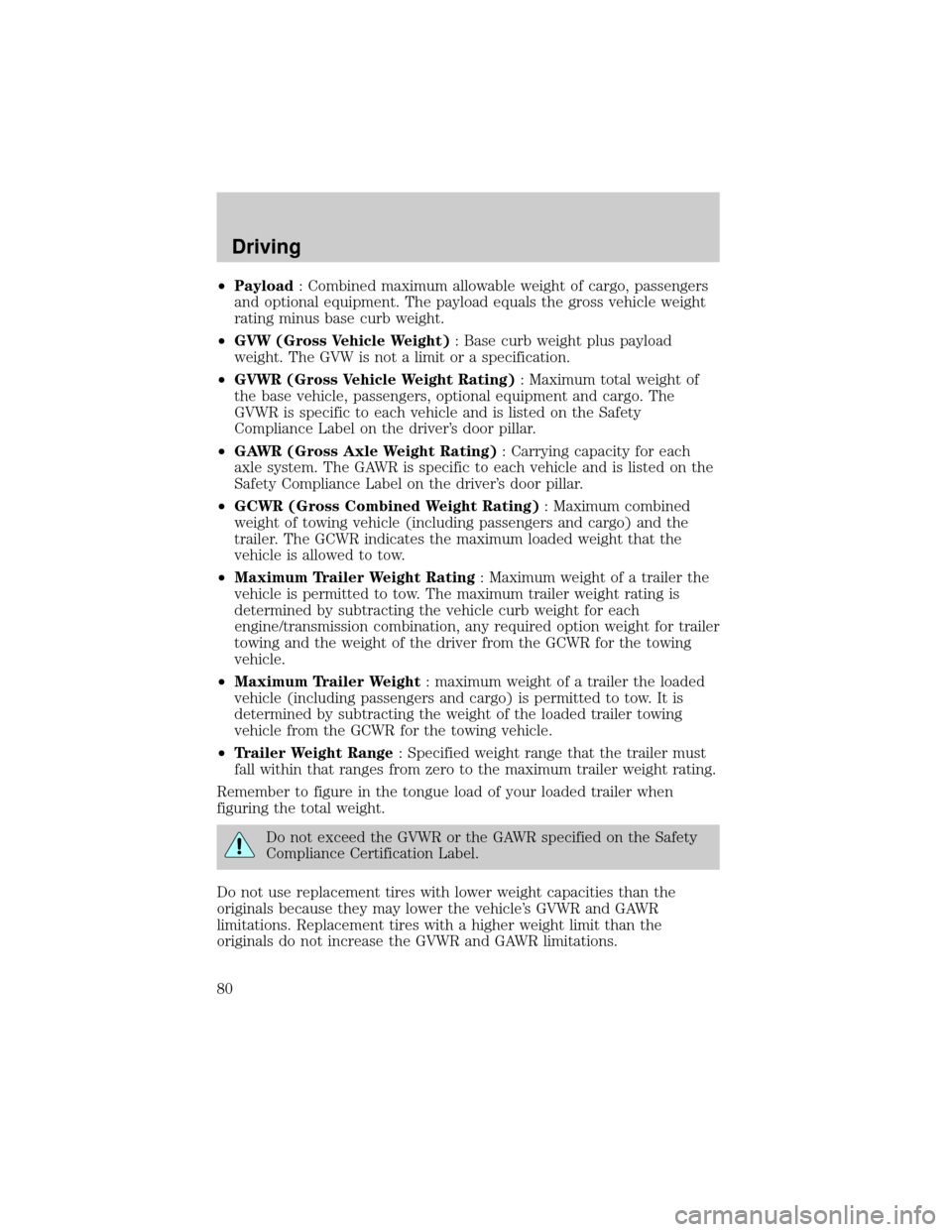1998 FORD RANGER weight
[x] Cancel search: weightPage 54 of 160

SAFETY SEATS FOR CHILDREN
Child and infant or child safety seats
Use a safety seat that is recommended for the size and weight of the
child. Carefully follow all of the manufacturer's instructions with the
safety seat you put in your vehicle. If you do not install and use the
safety seat properly, the child may be injured in a sudden stop or
collision.
When installing a child safety seat:
²Use the correct safety belt buckle
for that seating position.
²Make sure the tongue is securely
fastened in the buckle.
²Keep the buckle release button
pointing up and away from the
safety seat, with the tongue
between the child seat and the
release button, to prevent
accidental unbuckling.
²Place seat back in upright position.
²Put the safety belt in the automatic locking mode. Refer toAutomatic
locking mode.
Ford recommends the use of a child safety seat having a top tether
strap. Install the child safety seat in a seating position which is capable
of providing a tether anchorage. For more information on top tether
straps, refer toAttaching safety seats with tether straps.
Carefully follow all of the manufacturer's instructions included
with the safety seat you put in your vehicle. If you do not install
and use the safety seat properly, the child may be injured in a sudden
stop or collision.
Seating and safety restraints
54
Page 79 of 160

If speed control cancels after climbing the hill, reset speed by pressing
and holding the SET ACCEL button to resume speeds over 50 km/h
(30 mph).
Automatic transmissions may shift frequently while driving up steep
grades. Eliminate frequent shifting by shifting out of
(Overdrive) into
D (Drive).
Driving on snow and ice
A 4WD vehicle has advantages over 2WD vehicles in snow and ice but
can skid like any other vehicle.
Avoid sudden applications of power and quick changes of direction on
snow and ice. Apply the accelerator slowly and steadily when starting
from a full stop.
When braking, apply the brakes as you normally would. In order to allow
the anti-lock brake system (ABS) to operate properly, keep steady
pressure on the brake pedal.
Allow more stopping distance and drive slower than usual. Consider
using one of the lower gears.
TRACTION-LOK AXLE (IF EQUIPPED)
This axle provides added traction on slippery surfaces, particularly when
one wheel is on a poor traction surface. Under normal conditions, the
Traction-Lok axle functions like a standard rear axle.
Extended use of other than the manufacturer's specified size tires on a
Traction-Lok rear axle could result in a permanent reduction in
effectiveness. This loss of effectiveness does not affect normal driving
and should not be noticeable to the driver.
To avoid injury, never run the engine with one wheel off the
ground, such as when changing a tire.
VEHICLE LOADING
Before loading a vehicle, familiarize yourself with the following terms:
²Base Curb Weight: Weight of the vehicle including any standard
equipment, fluids, lubricants, etc. It does not include passengers or
aftermarket equipment.
Driving
79
Page 80 of 160

²Payload: Combined maximum allowable weight of cargo, passengers
and optional equipment. The payload equals the gross vehicle weight
rating minus base curb weight.
²GVW (Gross Vehicle Weight): Base curb weight plus payload
weight. The GVW is not a limit or a specification.
²GVWR (Gross Vehicle Weight Rating): Maximum total weight of
the base vehicle, passengers, optional equipment and cargo. The
GVWR is specific to each vehicle and is listed on the Safety
Compliance Label on the driver's door pillar.
²GAWR (Gross Axle Weight Rating): Carrying capacity for each
axle system. The GAWR is specific to each vehicle and is listed on the
Safety Compliance Label on the driver's door pillar.
²GCWR (Gross Combined Weight Rating): Maximum combined
weight of towing vehicle (including passengers and cargo) and the
trailer. The GCWR indicates the maximum loaded weight that the
vehicle is allowed to tow.
²Maximum Trailer Weight Rating: Maximum weight of a trailer the
vehicle is permitted to tow. The maximum trailer weight rating is
determined by subtracting the vehicle curb weight for each
engine/transmission combination, any required option weight for trailer
towing and the weight of the driver from the GCWR for the towing
vehicle.
²Maximum Trailer Weight: maximum weight of a trailer the loaded
vehicle (including passengers and cargo) is permitted to tow. It is
determined by subtracting the weight of the loaded trailer towing
vehicle from the GCWR for the towing vehicle.
²Trailer Weight Range: Specified weight range that the trailer must
fall within that ranges from zero to the maximum trailer weight rating.
Remember to figure in the tongue load of your loaded trailer when
figuring the total weight.
Do not exceed the GVWR or the GAWR specified on the Safety
Compliance Certification Label.
Do not use replacement tires with lower weight capacities than the
originals because they may lower the vehicle's GVWR and GAWR
limitations. Replacement tires with a higher weight limit than the
originals do not increase the GVWR and GAWR limitations.
Driving
80
Page 81 of 160

Calculating the load your vehicle can carry/tow
1. Use the Safety Compliance Certification Label to find the axle code
number and engine type for your vehicle.
2. Use the appropriate maximum gross combined weight rating (GCWR)
chart to find the maximum GCWR for your type engine and rear axle
ratio.
3. Weigh your vehicle as you customarily operate the vehicle without
cargo. To obtain correct weights, try taking your vehicle to a shipping
company or an inspection station for trucks.
4. Subtract your loaded vehicle weight from the maximum GCWR on the
following charts. This is the maximum trailer weight your vehicle can tow
and must fall below the maximum shown under maximum trailer weight
on the chart.
DRIVING THROUGH WATER
Do not drive quickly through standing water, especially if the depth is
unknown. Traction or brake capability may be limited and if the ignition
system gets wet, your engine may stall. Water may also enter your
engine's air intake and severely damage your engine.
If driving through deep or standing water is unavoidable, proceed very
slowly. Never drive through water that is higher than the bottom of the
hubs (truck)/wheel rims (car).
Once through the water, always try the brakes. Wet brakes do not stop
the vehicle as effectively as dry brakes. Drying can be improved by
moving your vehicle slowly while applying light pressure on the brake
pedal.
TRAILER TOWING
Your vehicle may tow a class I, II or III trailer provided the maximum
trailer weight is less than or equal to the maximum trailer weight listed
for your engine and rear axle ratio on the following charts.
Your vehicle's load capacity is designated by weight, not by volume, so
you cannot necessarily use all available space when loading a vehicle.
Towing a trailer places an additional load on your vehicle's engine,
transmission, axle, brakes, tires and suspension. Inspect these
components carefully after any towing operation.
Driving
81
Page 82 of 160

Trailer towing table (4x2 manual transmission)
Engine Rear
axle
ratioMaximum
GCWR-kg
(lbs.)Maximum
trailer
weight-kg (lbs.)
(0-maximum)Maximum frontal
area of trailer-m
2
(ft2)
Regular Cab 4x2
2.5L 3.45 Not recommended for trailer towing
2.5L 3.73 2 177
(4 800)0-717
(0-1 580)Equal to frontal
area of base vehicle
3.0L 3.45 2 267
(5 000)0-789
(0-1 740)Equal to frontal
area of base vehicle
3.0L 3.73 2 721
(6 000)0-1 225
(0-2 700)4.64 (50)
4.0L 3.08 2 267
(5 000)0-753
(0-1 660)Equal to frontal
area of base vehicle
4.0L 3.55 3 175 (7 000) 0-1 651 (0-3 640) 4.64 (50)
Regular Cab 4x2 (Splash or Special Suspension)
2.5L 3.73 2 177
(4 800)0-680
(0-1 500)Equal to frontal
area of base vehicle
3.0L 3.73 2 449
(5 400)0-907
(0-2 000)*Equal to frontal
area of base vehicle
4.0L 3.08 2 267
(5 000)0-717
(0-1 580)Equal to frontal
area of base vehicle
4.0L 3.55 2 495
(5 500)0-907
(0-2 000)*Equal to frontal
area of base vehicle
SuperCab 4x2
2.5L 3.73 2 177
(4 800)0-626
(0-1 380)Equal to frontal
area of base vehicle
3.0L 3.45 2 267
(5 000)0-698
(0-1 540)Equal to frontal
area of base vehicle
3.0L 3.73 2 271 (6 000) 0-1 133 (0-2 500) 4.64 (50)
4.0L 3.08 2 267
(5 000)0-635
(0-1 400)Equal to frontal
area of base vehicle
4.0L 3.55 3 175 (7 000) 0-1 542 (0-3 400) 4.64 (50)
Driving
82
Page 83 of 160

Trailer towing table (4x2 manual transmission)
SuperCab 4x2 (Splash or Special Suspension)
3.0L 3.73 2 540
(5 600)0-907
(0-2 000)*Equal to frontal
area of base vehicle
4.0L 3.08 2 267
(5 000)0-635
(0-1 400)Equal to frontal
area of base vehicle
4.0L 3.55 2 540
(5 600)0-907
(0-2 000)*Equal to frontal
area of base vehicle
*Optional payload is not available on 4x2 Splash or Special Suspension,
therefore maximum trailer weight is 907 kg. (2 000 lbs.).
For high altitude operation, reduce GCW by 2% per 300 meters
(1 000 ft.) elevation.
For definition of terms used in this table seeVehicle Loadingearlier
in this chapter.
To determine maximum trailer weight designed for your particular
vehicle, seeCalculating the loadearlier in this chapter.
Maximum trailer weight is shown. The combined weight of the
completed towing vehicle (including hitch, passengers and cargo) and
the loaded trailer must not exceed the Gross Combined Weight Rating
(GCWR).
Trailer tow table (4x4 manual transmission)
Engine Rear
axle
ratioMaximum
GCWR-kg
(lbs.)Maximum
trailer
weight-kg (lbs.)Maximum
frontal area of
trailer-m
2(ft2)
Regular Cab
3.0L 3.73 2 721 (6 000) 0-1 080 (0-2 380) Equal to frontal
area of base
vehicle.
4.0L 3.27 2 721 (6 000) 0-907 (0-2 000) Equal to frontal
area of base
vehicle.
4.0L 3.73 3 175 (7 000) 0-1 515 (0-3 340) Equal to frontal
area of base
vehicle.
Driving
83
Page 84 of 160

Trailer tow table (4x4 manual transmission)
Regular Cab (Splash)
3.0L 3.73 2 721 (6 000) 0-1 070 (0-2 360) 4.64 (50)
4.0L 3.27 2 721 (6 000) 0-907 (0-2 000) 4.64 (50)
4.0L 3.73 3 175 (7 000) 0-1 497 (0-3 300) 4.64 (50)
SuperCab
3.0L 3.73 2 721 (6 000) 0-1 007 (0-2 220) 4.64 (50)
4.0L 3.27 2 721 (6 000) 0-907 (0-2 000) 4.64 (50)
4.0L 3.73 3 175 (7 000) 0-1 442 (0-3 180) 4.64 (50)
SuperCab (Splash)
3.0L 3.73 2 721 (6 000) 0-998 (0-2 200) 4.64 (50)
4.0L 3.27 2 721 (6 000) 0-907 (0-2 000) 4.64 (50)
4.0L 3.73 3 175 (7 000) 0-1 424 (0-3 140) 4.64 (50)
For high altitude operation, reduce GCW by 2% per 300 meters
(1 000 ft.) of elevation.
For definition of terms used in this table, seeVehicle loadingearlier
in this chapter.
To determine maximum trailer weight designed for your vehicle, see
Calculating the loadearlier in this chapter.
Maximum trailer weight is shown. The combined weight of the
completed towing vehicle (including hitch, passengers and cargo) and
the loaded trailer must not exceed the Gross Combined Weight Rating
(GCWR).
Trailer towing table (4x2 automatic transmission)
Engine Rear
axle
ratioMaximum
GCWR-kg
(lbs.)Maximum trailer
weight-kg (lbs.)
(0-maximum)Maximum frontal
area of trailer-m
2
(ft2)
Regular Cab 4x2
2.5L 4.10 2 494 (5 500) 0-1 007 (2 220) Equal to frontal
area of base vehicle
3.0L 3.45 3 175 (7 000) 0-1 660 (0-3 660) 4.64 (50)
3.0L 3.73 3 401 (7 500) 0-1 814 (0-4 000) 4.64 (50)
4.0L 3.08 2 721 (6 000) 0-1 179 (0-2 600) 4.64 (50)
4.0L 3.55 4 309 (9 500) 0-2 721 (0-6 000) 4.64 (50)
Driving
84
Page 85 of 160

Trailer towing table (4x2 automatic transmission)
Regular Cab 4x2 (Splash or Special Suspension)
2.5L 3.73 2 449 (5 400) 0-907 (0-2 000)* Equal to frontal
area of base vehicle
3.0L 3.73 2 449 (5 400) 0-907 (0-2 000)* Equal to frontal
area of base vehicle
4.0L 3.08 2 495 (5 500) 0-907 (0-2 000)* Equal to frontal
area of base vehicle
4.0L 3.55 2 495 (5 500) 0-907 (0-2 000)* Equal to frontal
area of base vehicle
SuperCab 4x2
3.0L 3.73 3 401 (7 500) 0-1 796 (0-3 960) 4.64 (50)
4.0L 3.08 2 721 (6 000) 0-1 080 (0-2 380) 4.64 (50)
4.0L 3.55 4 309 (9 500) 0-2 676 (0-5 900) 4.64 (50)
SuperCab 4x2 (Splash or Special Suspension)
3.0L 3.73 2 540 (5 600) 0-907 (0-2 000)* Equal to frontal
area of base vehicle
4.0L 3.08 2 586 (5 700) 0-907 (0-2 000)* Equal to frontal
area of base vehicle
4.0L 3.55 2 586 (5 700) 0-907 (0-2 000) Equal to frontal
area of base vehicle
*Optional payload is not available on 4x2 Splash or Special Suspension,
therefore maximum trailer weight is 907 kg. (2 000 lbs.).
For high altitude operation, reduce GCW by 2% per 300 meters
(1 000 ft.) elevation.
For definition of terms used in this table seeVehicle Loadingearlier
in this chapter.
To determine maximum trailer weight designed for your particular
vehicle, seeCalculating the loadearlier in this chapter.
Maximum trailer weight is shown. The combined weight of the
completed towing vehicle (including hitch, passengers and cargo) and
the loaded trailer must not exceed the Gross Combined Weight Rating
(GCWR).
Driving
85